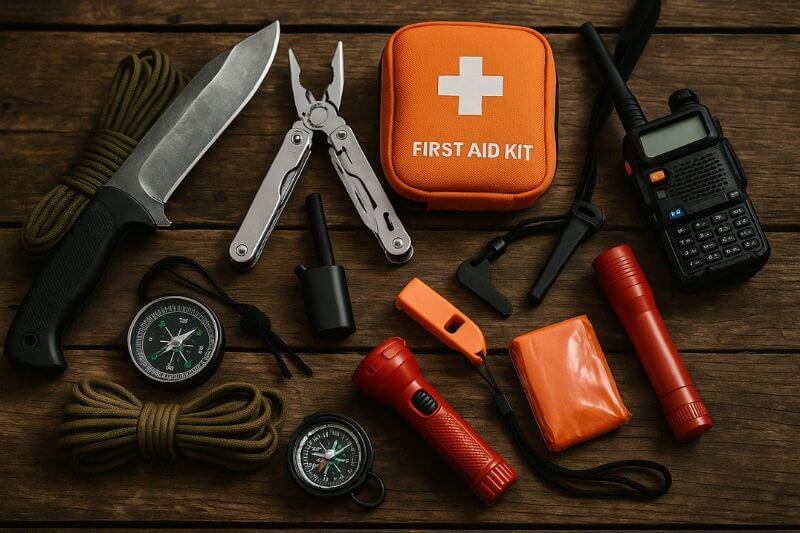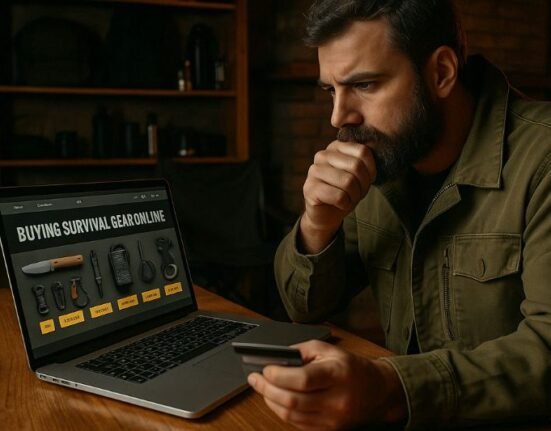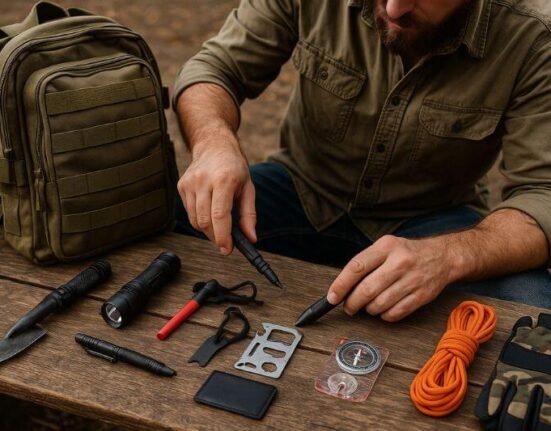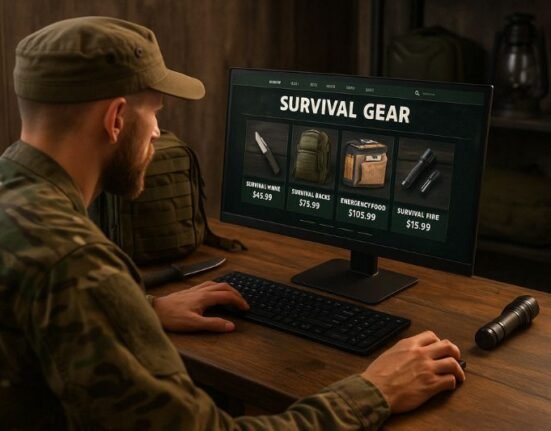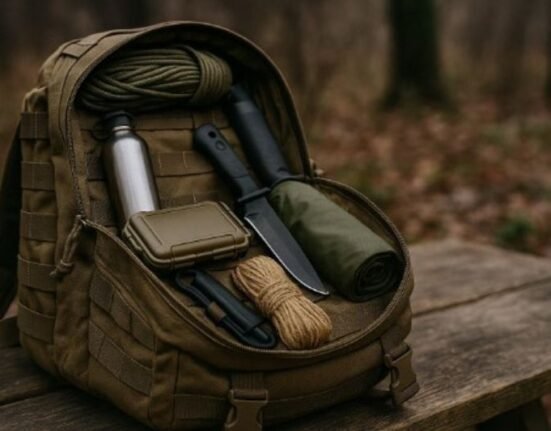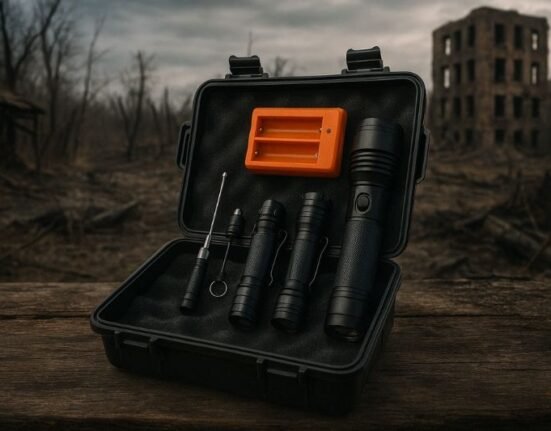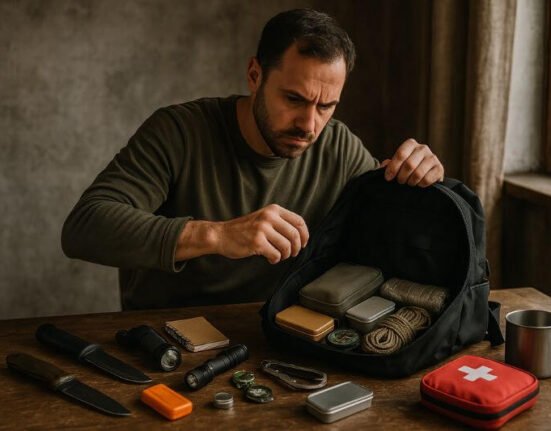When the grid goes down, chaos takes over, or nature strikes without warning, your gear becomes your lifeline. But not all tools are created equal. In the survival world, the difference between frustration and resilience often comes down to one thing: your emergency tools for survivalists.
These tools aren’t just for convenience—they’re your backup plan when everything else fails. Whether you’re facing a power outage, a natural disaster, or long-term off-grid living, having the right emergency tools for survivalists can mean the difference between control and vulnerability.
This guide breaks down the most essential emergency tools for survivalists, based on real-world use, field testing, and gear reliability—not hype. You’ll learn what to pack, why it matters, and how to avoid common gear failures that too many preppers discover too late.
Because in a real crisis, you don’t rise to the level of your gear—you fall to the level of your worst-prepared day.
🟦 What Makes a Tool “Emergency-Grade” for Survival?
In a market flooded with tactical-looking gadgets and survival-branded junk, it’s easy to get distracted by flash over function. That’s why seasoned preppers and off-grid veterans apply strict criteria when choosing emergency tools for survivalists. They know that in the field, looks don’t matter—performance does.
🔁 Multi-use Tools vs. Specialized Reliability
A common debate among preppers is whether to prioritize tools that do many things—or tools that do one thing very well. Both have a place in a smart kit.
- A multitool might seem perfect—until the pliers snap under tension or the blade dulls fast.
- A single-use tool, like a fixed-blade knife or ferro rod, often offers more durability and focus.
Emergency tools for survivalists should strike a balance: carry versatile items, but don’t compromise on critical-task gear like water filters, fire starters, or radios.
🧠 Rule: A good multitool supplements a real tool—it doesn’t replace it.
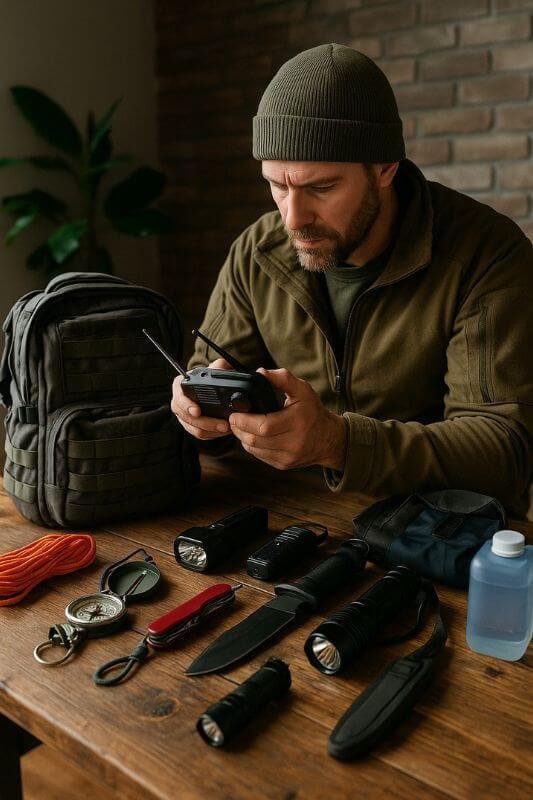
🧱 Key Criteria: Durability, Simplicity, Adaptability
What makes a tool worthy of your bug-out bag or INCH kit?
- Durability: Will it survive impact, water, cold, or months in storage?
- Simplicity: Can you operate it one-handed, in the dark, with gloves on?
- Adaptability: Will it still be useful if your plans or location change?
Emergency tools for survivalists must pass all three tests. A tool that only works in perfect conditions isn’t a survival tool—it’s dead weight.
✅ Example: A crank radio with solar panel and battery backup offers redundancy and adaptability. A flashlight that only takes one battery type, with no manual option? Risky.
📉 What Real Survivalists Learned From Gear Failures
One of the most overlooked aspects of prepping is post-failure analysis.
When gear fails, smart survivalists ask why:
- Was it poor material?
- Weak design?
- Wrong use case?
- Or just unreliable marketing?
Survivors of wildfires, hurricanes, and grid failures often report the same pattern: the gear that failed was either too cheap, too complex, or untested.
🧠 That’s why every list of emergency tools for survivalists should be based not on what looks cool—but on what has worked in real stress, cold, wet, or fear-driven scenarios.
🟦 Core Emergency Tools That Belong in Every Survival Kit
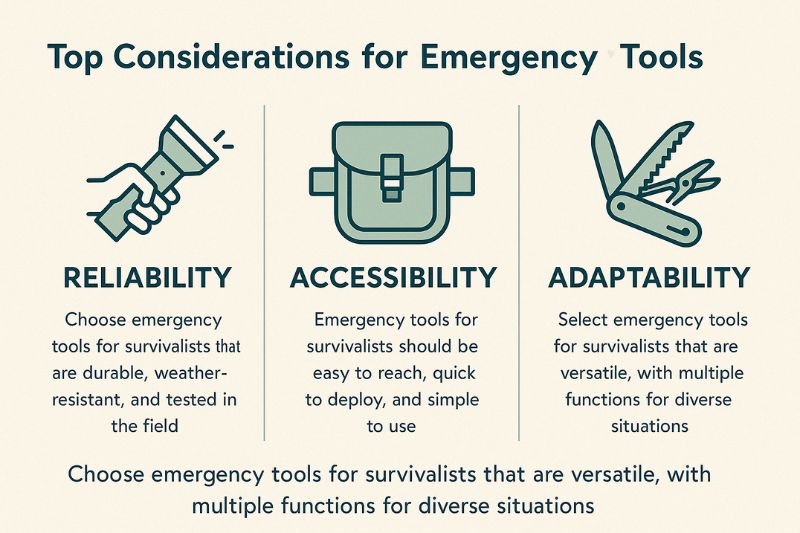
Every serious survivalist understands this truth: you don’t need more gear—you need the right gear. That’s why building your kit around proven, mission-critical emergency tools for survivalists is far more effective than chasing trends or filling space with gimmicks.
This section breaks down the core gear categories that should appear in any emergency kit—whether it’s for bugging out, sheltering in place, or surviving long-term off-grid scenarios.
Each of these emergency tools for survivalists has earned its place through real-world application, not marketing hype.
🔦 Flashlights and Headlamps (With Solar or Hand-Crank Options)
In a blackout, light equals control. Whether navigating dark woods or signaling in urban ruins, reliable lighting is non-negotiable.
✅ Must-have features:
- 200+ lumens minimum
- Waterproof or at least weather-resistant (IPX4+)
- Dual power sources: replaceable batteries, solar charge, or hand crank
- SOS/strobe mode for signaling
🧠 Emergency tools for survivalists in this category must work one-handed, survive drops, and function in cold. Headlamps allow hands-free movement—ideal for setting up camp, repairing gear, or treating wounds.
📻 Emergency Radios (NOAA Alerts, Crank, Battery, USB)
Communication saves lives. A good emergency radio lets you:
- Get weather warnings
- Monitor local disaster reports
- Charge your phone
- Use it as a flashlight or SOS beacon
Look for:
- NOAA alert reception
- Hand crank AND USB charging
- Built-in flashlight and battery pack
- AM/FM + shortwave if possible
🧠 Don’t buy a radio that depends on cell service or Wi-Fi. True emergency tools for survivalists are designed for total grid failure.
💧 Portable Water Filters and Purifiers
Water is life. But only if it’s safe.
Essential features:
- Hollow fiber membrane or activated carbon
- Removes bacteria, protozoa, and ideally viruses
- Compact enough to fit in a pouch or pocket
- Compatible with bags/bottles for bulk use
Examples: Sawyer Mini, MSR Guardian, LifeStraw + chemical tablets as backup
🧠 One of the top emergency tools for survivalists—especially in flood, wilderness, or urban collapse scenarios.
🔪 Fixed Blade Knives and Multitools
The knife is the backbone of survival. Whether processing firewood, food, or shelter materials—it must be strong, sharp, and dependable.
✅ Look for:
- Full-tang construction
- Steel: 1095, 440C, or equivalent (avoid mystery metals)
- Simple sheath system (belt or MOLLE)
- Comfortable grip in all weather
Multitools add flexibility, but never replace a true knife. Choose Leatherman-style multitools with pliers, wire cutters, screwdrivers, etc.
🧠 A knife is one of the most personal emergency tools for survivalists. Choose one that fits your hand, your skill level, and your terrain.
🔥 Fire Starters (Ferro Rods, Waterproof Matches, Sparkers)
Fire equals heat, purification, morale, and light.
Carry at least two fire-starting methods:
- Ferrocerium rod (throws sparks even when wet)
- Waterproof/stormproof matches in sealed capsule
- Lighter (butane or plasma, with backup fuel)
- Tinder kit: waxed cotton, jute, fatwood, magnesium shavings
🧠 In cold or wet conditions, ferro rods outperform nearly everything. They’re the most reliable emergency tools for survivalists in harsh terrain.
🩹 First Aid Kits (Realistic, Trauma-Ready, Modular)
Forget the hotel-style kits with 30 band-aids and no tourniquet.
A real survivalist first aid kit should include:
- Trauma shears
- Tourniquet (CAT or SWAT)
- Israeli bandage or pressure dressing
- Burn treatment
- Nitrile gloves
- Antiseptics, antihistamines, pain relief
- Medication packs (customized per user)
🧠 One of the most underestimated emergency tools for survivalists. In a long-term event, medical help might not come—your gear must become your medic.
🟦 How to Evaluate and Test Your Emergency Tools BeforeYou Rely on Them
Anyone can buy survival gear. But not everyone takes the time to test it—and that’s where real survivalists separate themselves from amateurs.
No matter how well-reviewed a product is or how tactical it looks, it’s not a survival tool until you’ve used it in a real scenario—or simulated one. That’s why testing and vetting your emergency tools for survivalists is just as important as owning them.
Here’s how to make sure your gear won’t fail when it matters most.
🧪 Field Performance vs. Marketing Promises
Most gear looks great online. Crisp packaging, catchy names, and hundreds of glowing reviews. But in the field, it’s a different story.
Ask yourself:
- Does the tool work with gloves or cold fingers?
- Can it be used one-handed in low light or rain?
- Is it still functional after being dropped, frozen, or soaked?
🔥 Example: Many “tactical” flashlights boast 1000+ lumens, but overheat or flicker in wet conditions. A $20 light that survives rough use is more valuable than a $60 gadget that dies in the dark.
🧠 Rule: Emergency tools for survivalists must be tested beyond the packaging—in the dirt, in the rain, in the real world.
⚠️ Tools That Failed Under Pressure (and What Replaced Them)
Preppers who’ve faced real disasters—from hurricanes to riots—often report recurring gear failures:
- Fire starters that wouldn’t spark in high humidity
- Radios that broke after one fall
- Filters that leaked or clogged mid-use
- Multitools that snapped under torque
- Medical kits that lacked even basic trauma supplies
These stories aren’t just cautionary tales—they’re blueprints for smarter prepping.
🧠 Every piece of failed gear teaches a lesson. The most reliable emergency tools for survivalists are usually simple, rugged, and tested repeatedly by others in the field.
🧰 Minimalist vs. Modular Kits: Which Works Best?
The best emergency kit isn’t the heaviest—it’s the most efficient.
Two approaches dominate:
1. Minimalist Setup
- Ultralight, compact
- Every item must earn its space
- Ideal for solo travel or fast bug-outs
2. Modular Setup
- Organized by scenario (injury, comms, shelter, tools)
- Allows for fast swaps or additions
- Preferred for long-term homesteading or family setups
🧠 Whichever you choose, every module must contain proven emergency tools for survivalists—not gadgets you’ve never tested.
🔄 Combining Tools Smartly: Redundancy Without Clutter
One of the smartest prepper principles is:
👉 “Two is one, one is none.”
That means building layers of redundancy without excess.
For example:
- A flashlight that doubles as a power bank
- A knife with a built-in fire striker
- A radio that includes solar + crank + USB charging
- A water filter that works alone or in-line with a hydration bladder
🧠 Don’t just carry gear—integrate gear. The most effective emergency tools for survivalists are multipurpose, scalable, and synergistic.
❓ Frequently Asked Questions (FAQ)
🔧 What are the most essential emergency tools for survivalists?
At the core of any survival setup, a few tools stand out as truly essential:
- A reliable fixed-blade knife for cutting, shelter building, and food prep
- A ferro rod or stormproof fire starter for warmth and cooking
- A portable water filter (Sawyer Mini, LifeStraw, etc.)
- A compact, solar/crank flashlight
- A realistic first aid kit with trauma care
- An emergency radio that works without grid power
These are the emergency tools for survivalists that cover the “Rule of Threes”: 3 minutes without air, 3 hours without shelter, 3 days without water, and 3 weeks without food.
🧠 If a tool helps you meet those thresholds—it’s essential.
☀️ Are solar-powered tools actually reliable in long-term survival scenarios?
Yes—but with limits.
Solar-powered emergency tools are valuable for sustained off-grid use, especially:
- Radios with solar and crank charging
- Flashlights with integrated panels
- Battery packs that trickle-charge over days
However, they’re not foolproof. Cloud cover, limited daylight, and low-quality panels can reduce output dramatically.
🧠 Smart survivalists use solar gear as a backup, not the only power source. The most effective emergency tools for survivalists pair solar with USB, battery, or manual options.
🔄 How do I test emergency gear before trusting it?
Testing should mimic real-world conditions, not just tabletop use.
✅ Try this:
- Start a fire in the rain or with wet gloves
- Filter dirty water from a puddle
- Use your flashlight after freezing it overnight
- Treat a mock wound using only your IFAK
- Tune into NOAA weather bands with your radio in a rural area
The point is to simulate stress, cold, wet, fatigue, and time pressure.
🧠 Your emergency tools for survivalists should feel instinctive—not confusing—when everything is on the line.
⚠️ Which survival tools are often overhyped or unnecessary?
Plenty of gear looks impressive but fails when tested. Some examples:
- Credit card multitools (too small, no leverage)
- Cheap “tactical pens” (break easily, poor glass breakers)
- Overbuilt survival shovels (heavy, poor performance)
- All-in-one tools with 10+ features (none of which work well)
- Flashlights that require rare or proprietary batteries
🧠 Focus on core performance, not marketing. True emergency tools for survivalists are boring, rugged, and built to work—not impress.
📦 Can I build a complete survival kit on a tight budget without sacrificing quality?
Absolutely—but it requires planning and prioritization.
Start with:
- Basic but quality items (e.g., Mora knife, BIC lighter, Sawyer Mini)
- Second-hand gear from military surplus or trusted marketplaces
- DIY fire starters and home-built first aid kits
- Avoid unnecessary duplication—each item must earn its weight
Over time, upgrade based on experience.
🧠 Even budget emergency tools for survivalists can outperform flashy gear if they’re well-chosen and tested.









